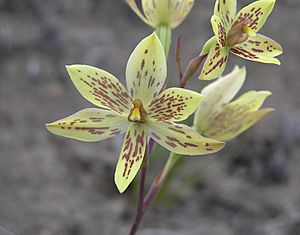Swamp sun orchid facts for kids
Quick facts for kids Swamp sun orchid |
|
|---|---|
 |
|
| Thelymitra cucullata in the Coolinup Nature Reserve near Condingup | |
| Scientific classification | |
| Genus: |
Thelymitra
|
| Species: |
cucullata
|
The swamp sun orchid (scientific name: Thelymitra cucullata) is a special type of orchid. It only grows in the south-west part of Western Australia. This means it's endemic to that area, found nowhere else in the world! It has one thin leaf and can grow up to ten small flowers. These flowers are usually greenish-cream or white with purple spots. They tend to droop quickly after they have been pollinated.
Contents
What Does the Swamp Sun Orchid Look Like?
The swamp sun orchid is a tuberous plant. This means it grows from a round, underground storage part, like a small potato. It's also a perennial herb, which means it lives for more than two years and has soft stems, not woody ones.
Each plant has one long, thin leaf. This leaf can be about 10 to 18 centimeters (4 to 7 inches) long. It is usually about 3 to 4 millimeters (0.1 to 0.2 inches) wide.
Flowers and Stems
The plant grows a flowering stem that can be 20 to 45 centimeters (8 to 18 inches) tall. On this stem, you'll find between two and ten flowers. These flowers are greenish-cream or white with purple blotches. Each flower is about 12 to 18 millimeters (0.5 to 0.7 inches) wide.
Orchid flowers have special parts:
- Sepals and Petals: These are like the outer leaves of the flower. They are usually 6 to 9 millimeters (0.2 to 0.4 inches) long. The top sepal is wider than the others.
- Labellum: This is the lowest petal of the orchid. It's often shaped differently and is narrower than the other petals.
- Column: This is a central part of the flower. It holds the parts that help with pollination. The column is usually 4 to 5 millimeters (0.16 to 0.2 inches) long. It has purple spots and short, yellow-tipped arms on its sides.
Life Cycle and Pollination
These orchids are self-pollinated. This means they can fertilize themselves without needing insects or other plants. Their flowers are short-lived and only open on sunny days. After they are pollinated, they quickly droop. You can usually see these orchids flowering in October and November.
How the Swamp Sun Orchid Got Its Name
The scientific name for this orchid, Thelymitra cucullata, was first officially written down in 1946. This was done by a person named Herman Rupp. He found a sample of the plant in the Stirling Range. His description was published in a magazine called Australian Orchid Review.
The second part of its name, cucullata, comes from a Latin word. It means "hooded." This name was chosen because the top sepal of the flower forms a shape like a hood over the column.
Where the Swamp Sun Orchid Lives
The swamp sun orchid likes to grow in places that are wet during winter. You can find it around the edges of swamps. It also grows in shallow soil on top of granite rocks. This orchid is found in Western Australia, stretching from the city of Perth all the way to Israelite Bay.
Is the Swamp Sun Orchid Safe?
The Western Australian Government's Department of Parks and Wildlife has looked at the swamp sun orchid. They have officially said that it is "not threatened." This means there are enough of these orchids, and they are not currently in danger of disappearing.

